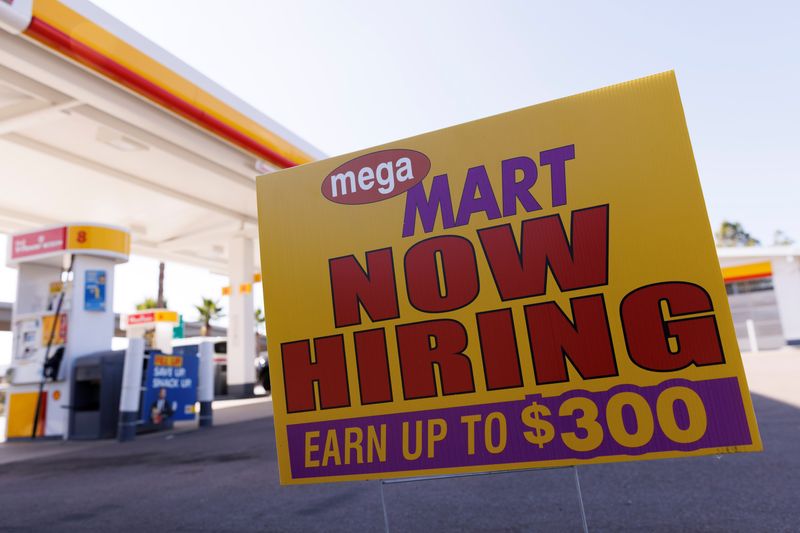By Lucia Mutikani
WASHINGTON (Reuters) - U.S. private employers hired the fewest workers in two years in April amid chronic labor shortages and rising costs, which are hitting small businesses the hardest, raising the possibility that overall job growth slowed considerably last month.
That was reinforced by a separate survey from the Institute for Supply Management (ISM) on Wednesday showing a measure of services sector employment contracted in April for the second time this year. Services businesses in the ISM survey described demand for workers as remaining "hypercompetitive," noting that "there is just not enough qualified personnel available."
Government data on Tuesday showed there were a record 11.5 million job openings on the last day of March, which pushed up the jobs-workers gap to a record 3.4% of the labor force from 3.1% in February.
"The softer trend is consistent with a slowing in job growth that we expect to start in April," said Veronica Clark, an economist at Citigroup (NYSE:C) in New York. "Softer monthly job gains would likely be due to labor shortages."
Private payrolls rose by 247,000 jobs last month, the smallest gain since April 2020, after increasing 479,000 in March. The slowdown in hiring was across the board, with leisure and hospitality industry payrolls rising by 77,000 jobs, the fewest since late 2020. Manufacturing employment increased by 25,000 jobs, while construction added 16,000 positions.
All the employment gains last month were in medium and large companies. Businesses with less than 50 employees reported a decline in payrolls. Economists polled by Reuters had forecast private payrolls would increase by 395,000 jobs.
The government reported last week that compensation for American workers notched its largest increase in more than three decades in the first quarter.
Soaring wages because of tightening labor market conditions are helping to fuel inflation, prompting an aggressive response from the Federal Reserve. The U.S. central bank on Wednesday raised its policy interest rate by half a percentage point, the biggest hike in 22 years, and said it would begin trimming its bond holdings next month as it fights inflation.
Stocks on Wall Street were trading higher. The dollar dipped against a basket of currencies. U.S. Treasury prices were mixed.
Graphic: ADP - https://graphics.reuters.com/USA-STOCKS/xmvjoyykepr/adp.png
EXCESS DEMAND ENVIRONMENT
The ADP report is jointly developed with Moody's (NYSE:MCO) Analytics and was published ahead of the release on Friday of the Labor Department's more comprehensive and closely watched employment report for April. It has, however, a poor record predicting the private payrolls count in the department's Bureau of Labor Statistics employment report because of methodology differences.
Still, there is no doubt that the dearth of workers is hampering hiring. The ISM survey showed its services industry employment gauge fell to 49.5 last month after rebounding to 54.0 in March. The contraction, together with supply bottlenecks and a slowdown in orders, restrained services sector growth.
Services businesses are also being hindered by inflation, with the survey's measure of prices paid for inputs climbing to an all-time high in April.
The ISM reported earlier this week that manufacturing employment pulled back considerably in April. The raft of relatively soft employment measures could temper expectations for strong job gains in April. According to a Reuters survey of economists, nonfarm payrolls likely increased by 391,000 jobs last month after rising 431,000 in March.
"Difficulty finding workers is holding back services firms from increasing employment, which may cause a downside surprise to this Friday's April payrolls report," said Will Compernolle, a senior economist at FHN Financial in New York.
Last month's softening in the services sector, coming on the heels of news from the ISM on Monday that manufacturing grew at its slowest pace in more than 1-1/2 years in April, suggests supply constraints are becoming more binding again, thanks to Russia's war against Ukraine and new COVID-19 lockdown in China.
The ISM's non-manufacturing activity index fell to a reading of 57.1 from 58.3 in March. A reading above 50 indicates expansion in the services sector, which accounts for more than two-thirds of U.S. economic activity.
Graphic: ISM services PMI - https://graphics.reuters.com/USA-STOCKS/zjvqkmmjavx/ism.png
"We remain in an environment of excess demand, constrained supply and surging prices," said Conrad DeQuadros, senior economic advisor at Brean Capital in New York.
Indeed, a third report from the Commerce Department on Wednesday showed the trade deficit accelerated 22.3% to a record$109.8 billion in March, with imports also setting an all-time high. Imports of goods and services jumped 10.3% to $351.5 billion, outpacing a 5.6% rise in exports to $241.7 billion.
Businesses imported a range of goods including petroleum, motor vehicles and parts, apparel, household items, footwear, as well as toys, games and sporting goods. Imports of services also increased, lifted by transport and travel, but charges for the use of intellectual property decreased $1.2 billion.
The nation exported more crude oil and natural gas liquids as well as motor vehicle and parts. Exports of services increased, boosted by transport, travel, financial services and other business services.

Graphic: Trade balance - https://graphics.reuters.com/USA-STOCKS/dwpkryydkvm/tradebal.png
"What the huge demand for imported goods does show is that America may have more of a demand problem than a supply problem," said Christopher Rupkey, chief economist at FWDBONDS in New York. "As long as import demand keeps setting records, it shows the Fed has to keep pushing interest rates up and up because American consumers and businesses are not done buying yet and strong demand keeps the inflation fires burning."